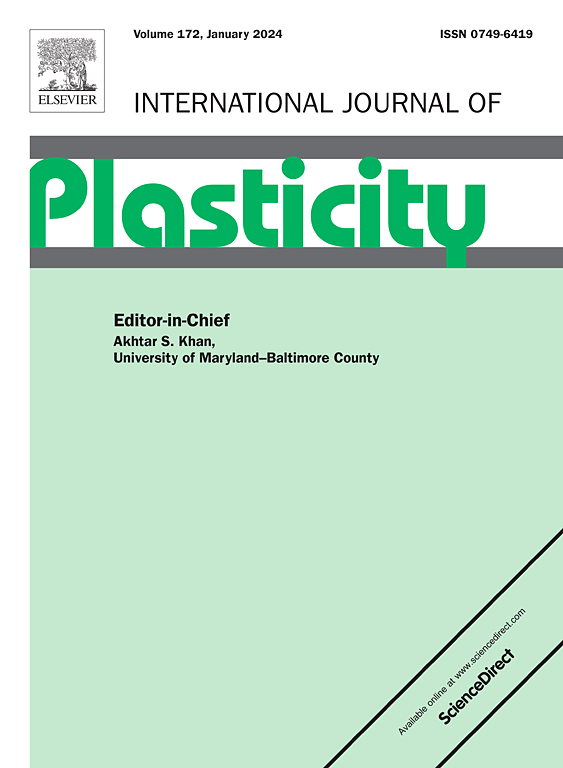钛合金中电塑性效应的机理与建模:基于位错滑移的视角
IF 12.8
1区 材料科学
Q1 ENGINEERING, MECHANICAL
引用次数: 0
摘要
电辅助成形技术是制造钛合金难成形部件的重要技术之一。然而,电塑性效应对材料变形行为的影响机制尚不清楚,且电塑性效应耦合的本构模型较少,阻碍了电流的应用。本文从位错滑移的钉扎、脱剥落、拖拽和释放四个阶段研究了EP对变形行为的影响机制。研究发现,热极电效应在钉钉、脱钉和释放阶段均存在,其作用机制与热辅助变形阶段相同。非热极电位效应通过促进溶质向位错线扩散和在钉住点处产生自由能来增强位错钉住和脱钉行为。而非热EP效应对释放期无影响。然后,建立了基于物理的EA本构模型。采用热激活理论对钉钉和脱钉阶段进行热效应模拟,采用Seeger关系对释放阶段进行热效应模拟。基于电迁移理论和金属键溶解理论,通过对移动位错附近溶质浓度的评价,模拟了钉钉阶段的非热效应。此外,基于自由能理论,通过计算钉钉点处产生的自由能,模拟了脱钉阶段的非热效应。该模型预测能力强,适用范围广。基于该模型,量化了不同EA变形条件下热和非热极电效应对流动应力的贡献。本文章由计算机程序翻译,如有差异,请以英文原文为准。

Mechanism and modelling of the electroplastic effect in titanium alloy: From the perspective of dislocation slip
Electrically assisted (EA) forming technology has gained attention for manufacturing the difficult-to-form components of titanium alloy. However, the mechanism of the electroplastic (EP) effect on deformation behaviors remains unclear and the EP effect-coupled constitutive models are scarce, which hinders application of electrical current. In this study, the mechanism of the EP effect on deformation behavior was investigated from pinning, depinning, drag and release stages of dislocation slip. It is found that the thermal EP effect presented in pinning, depinning and release stages, whose mechanism was the same as that in thermally-assisted deformation. In contrast, the athermal EP effect enhanced dislocation pinning and depinning behaviors through promoting solute diffusion to dislocation line and generation of the electrical free energy at pinning points, respectively. While, the athermal EP effect didn’t influence the release stage. Then, a physically based EA constitutive model was established. The thermal effect was modelled using thermal activation theory for pinning and depinning stages and Seeger’s relation for release stage. The athermal effect on pinning stage was modelled by evaluating solute concentration near mobile dislocations based on electromigration theory and metallic bond dissolution theory. Besides, the athermal effect on depinning stage was modelled by calculating the electrical free energy generated at pinning points based on electrical free energy theory. The model provided good predictive ability and wide application range. Based on the model, the contributions of the thermal and athermal EP effects to flow stress were quantified under various EA deformation conditions.
求助全文
通过发布文献求助,成功后即可免费获取论文全文。
去求助
来源期刊

International Journal of Plasticity
工程技术-材料科学:综合
CiteScore
15.30
自引率
26.50%
发文量
256
审稿时长
46 days
期刊介绍:
International Journal of Plasticity aims to present original research encompassing all facets of plastic deformation, damage, and fracture behavior in both isotropic and anisotropic solids. This includes exploring the thermodynamics of plasticity and fracture, continuum theory, and macroscopic as well as microscopic phenomena.
Topics of interest span the plastic behavior of single crystals and polycrystalline metals, ceramics, rocks, soils, composites, nanocrystalline and microelectronics materials, shape memory alloys, ferroelectric ceramics, thin films, and polymers. Additionally, the journal covers plasticity aspects of failure and fracture mechanics. Contributions involving significant experimental, numerical, or theoretical advancements that enhance the understanding of the plastic behavior of solids are particularly valued. Papers addressing the modeling of finite nonlinear elastic deformation, bearing similarities to the modeling of plastic deformation, are also welcomed.
 求助内容:
求助内容: 应助结果提醒方式:
应助结果提醒方式:


